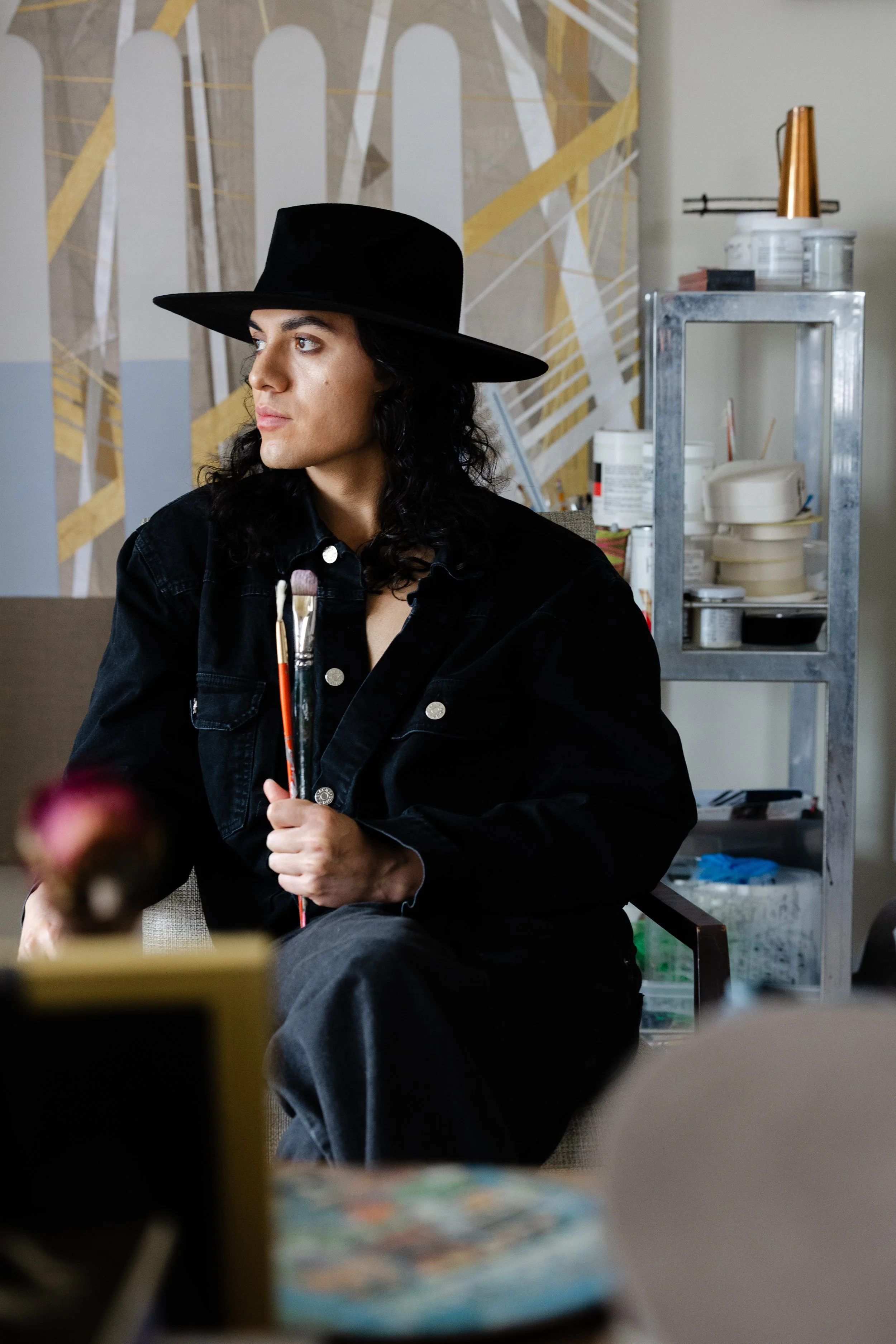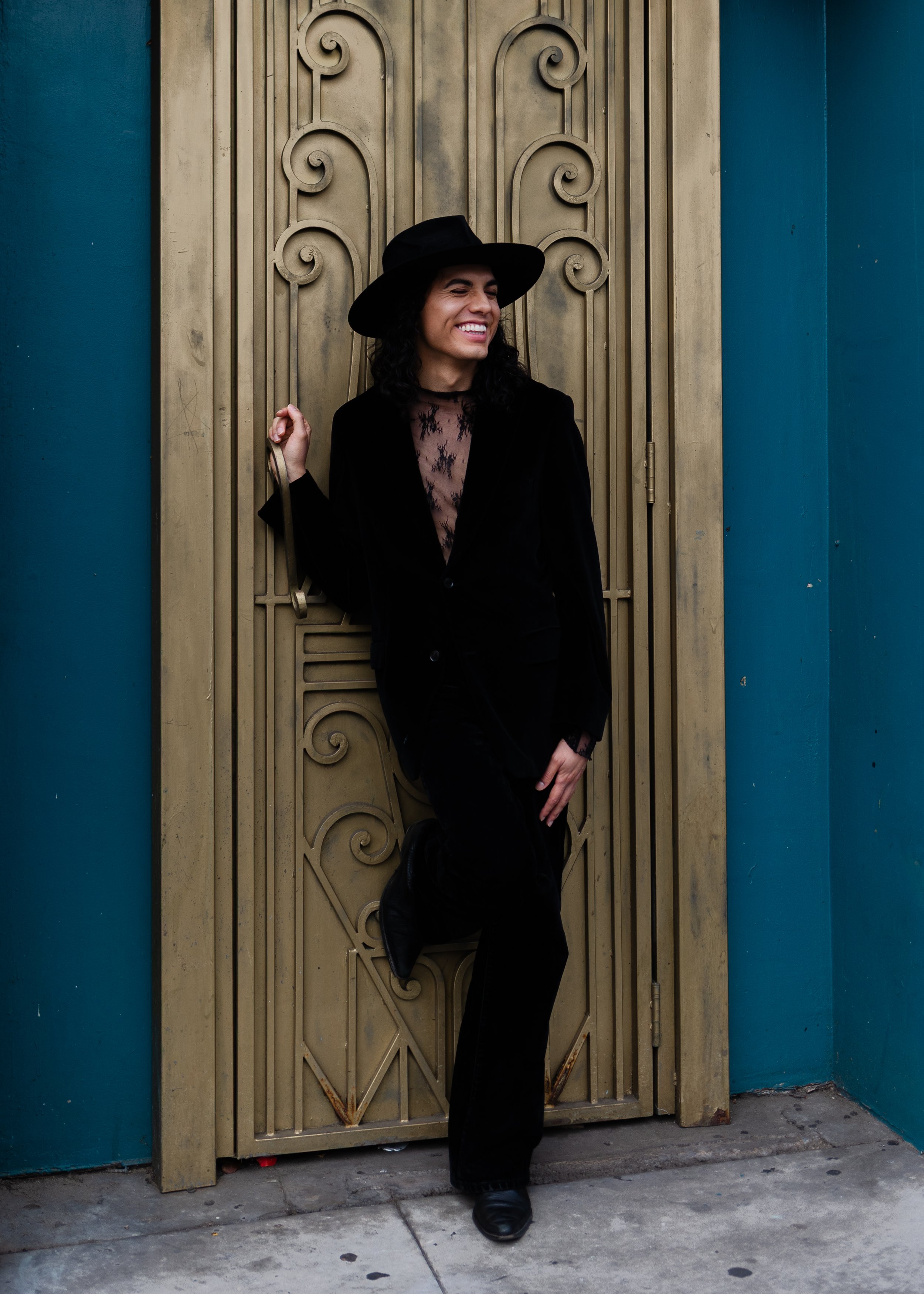Amadour: An interdisciplinary artist shaped by SMC and exploring queer identity through art











Amadour’s multifarious approach to art, specifically their paintings, is positively unique, continuing to challenge topics like cultural heritage and identity. Their use of texture and bright gold colors is intricate and refined, tying back to their Mexican and Colombian roots. Their art reflects and celebrates the architecture of Santa Monica and Reno, Nevada. Strong, defined archways with crisp blues and hues of silver– the color blocking really makes their work feel distinctive, as they explore geometric abstraction.
Amadour, a former Santa Monica College (SMC) and University of California, Los Angeles (UCLA) alum is a 29-year-old artist who relocated to Los Angeles from Reno. From the time they were a child, Amadour has always been driven by creativity and passion. “I loved drawing fairies and angels, like, little garden angels. I always drew myself with a fairy. I’d call them “manas” [hermana translates to sister in Spanish],” Amadour said.
As a child, Amadour found their love for all things art despite that they “grew up in a small apartment in Reno with my mom. I grew up in a divorced household. So it was two days here, three days there. It was always back and forth. I had all these crayons and colored pencils and things, and one day I saw a microphone for this karaoke machine we had, and I was like, I’m going to be a singer someday,” they said.
When it comes to Amadour’s identity, they said, “As a nonbinary person, it was just a lot of figuring things out. There's no direction. I think that those things kind of enlisted in me like, wait, I think I really like to draw and I think I like music, you know?”
Amadour said, “I identified as genderfluid for a minute, but nonbinary really made sense to me because I was like, yeah, I don’t identify as male or female. I’m not talking about sexual orientation or sex, but gender, because none of them add up. I’m just my own box. I feel like that's nonbinary.”
Even as a kid, Amadour was fascinated with architecture, drawing tons of architectural maps, and obsessed with casinos, which are found in abundance in the bright city of Reno. They wanted to be among the skyscrapers. “I’d make my own fictitious casinos, and I feel like I still have a little Nevada casino in me, because I use gold and stuff. It’s a little bit glammed out and that’s just part of my personality and existence,” Amadour said.
Right now, Amadour is working on The Mapes Suite, a visual and musical project that will debut as their first institutional show next year. The project is based on Black, queer, and Hollywood history from the historic Mapes Hotel that was demolished in Reno. They were at the demolition at just five years old, in 2000. “I came back to it recently, and I was like, oh my gosh, I want to look back into it. Marilyn Monroe and Clark Gable did their last movie there, “The Misfits”. Sometimes it’s a historical reference or a research standpoint that gets me invested in a certain iconography or prediction of what I’m going to paint next,” Amadour said.
When planning their next painting, Amadour’s ideas start to congregate– their culmination of art knowledge aids them as they decide what they want their paintings to be, and to represent. “I realized that Nevada for me is not just my home state, but it’s a place where so many stories have been whitewashed. They’ve been coated with slang, been made about gambling, about being in the wild west, about Americana. All these things are fluid and exist, but they also have overlapped with the erasure of so many people that have gone completely unnoticed in the historical framework,” Amadour said.
Regarding whether certain themes are always prevalent in the art that they produce, Amadour said, “I would say yes and no. It's project-based. I’m working on my next body of work, which was initially supposed to be an EP. It’s likely to be an album. I’ve had to decipher my own mythology before other people could really decipher it with me. Because it wasn’t built for me to have a lane.”
“The people who make music like me don’t look like me. The people who sound like me don’t address the points I want to discuss. The people I look up to are not necessarily those who relate to my lived experience. It’s not that I'm refraining from supporting others; I love all of my influences, acknowledge them, and appreciate them. However, I've realized I’m really in my own lane on this one. It’s liberating, but also terrifying,” Amadour said.
Amadour has been songwriting since they were thirteen years old, some songs come to fruition years later, like upcoming singles from their forthcoming debut album I Was Born in the Silver and I Died There Too— “Someone Left to Love” and “I Want to Be Your Sailor.” It dives into the hard question— are you going to leave me behind? It goes into Amadour’s family situation, specifically their grandma passing away, and the realization of a blunt lover's words, knowing that they’ve moved on.
“Maybe there's something I want for myself. Maybe there's something that is bigger than this. I go into all of these mood swings where I’m thinking about, you know, I like all of these past things or these present things. “I Want to Be Your Sailor” is like the ultimate love song. It’s like, I love you no matter what conditions. I chose you. I’ve never heard a ballad for myself– even though I love so many balladeers, like Sam Smith, but I've never heard a ballad that was geared to a place of just true, like, I love you, from a queer point of view. And that is this song,” Amadour said.
When it comes to the feelings Amadour wants to convey with this work, they said, “The way I want people to interact with what I'm working on musically, is just know that this is for you, not for me. I’m laying it all out. If you vibe with it, please. I kind of feel like it’s a gay girl anthem too, to be honest. But that’s just me. In terms of art, It’s a little different. I think that it’s a little bit more of a confrontation with the spatiality of how you’re interacting with it. It becomes a portal, a queer portal, where you can really enter.”
Amadours wants their work to feel like a safe place. It is structured to be a portal to wherever the viewer needs, to make them feel like they belong, that they are meant to be there, even if it’s unknown or terrifying, even if it feels like life is a twisting road of chaos.
To any young inspiring artists, “I’m a high school dropout. I should have never gotten into UCLA the way I did. Even though sometimes it feels like you should just completely stop your project, that might be a moment to trust yourself even more and get even more introspective. Sometimes, your best work comes out from the moment where you’re living with the most fear or the most inadequacy, or where there’s so many things going on in the world that you feel limited. I think that even in those moments, create. Because sometimes that's the most powerful thing you could do,” Amadour said.
David Quadrini, a respected art dealer and artist, has known Amadour for about six or seven years. Quadrini founded Angstrom Gallery in Dallas, Texas for around 15 years, leading to the two of them meeting. Quadrini said, “I think it’s pretty true that most people in the art world know at least half of the rest of the people in the art world. It’s one of the largest sort of friends-and-family businesses left in the world, I think.”
Regarding Amadour’s work specifically, Quadrini said, “Very beautiful. It has this mid-century quality, which makes it more utopian than post- mid century. It’s all very architectural, but all very much presenting the feeling that was buildings and bridges and machines. The whole Charles Sheeler kind of thing.” Quadrini believes that Amadour is more of a contemporary– someone who’s connected to a lot more cultures than the average art producer.
When asked to describe Amadour in three simple words, Quadrini said, “Confident, clever, and kind.”
Fusing physical mediums of art and music is a big part of Amadour. But, which one do they prefer? Amadour said, “It's like asking, do you prefer to taste or see? Both. I can’t do without the other, I have to taste it. I need to taste the salt in the air to know I’m by the ocean. I need to see the fog coming in to know that it’s changing light of day. It’s so experimental for me. And I feel so privileged to be in a time where artists like myself can blend those together, and it’s not ostracized or not looked at like you have to be a master of one type of fixture.”
Amadour isn’t seeking mastery— they want the emotions, and they want the feelings that come along with creation.
